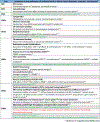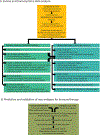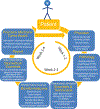Precision oncology in the age of integrative genomics
- PMID: 29319699
- PMCID: PMC6364676
- DOI: 10.1038/nbt.4017
Precision oncology in the age of integrative genomics
Abstract
Precision oncology applies genomic and other molecular analyses of tumor biopsies to improve the diagnosis and treatment of cancers. In addition to identifying therapeutic options, precision oncology tracks the response of a tumor to an intervention at the molecular level and detects drug resistance and the mechanisms by which it occurs. Integrative genomics can include sequencing specific panels of genes, exomes, or the entire triad of the patient's germline, tumor exome, and tumor transcriptome. Although the capabilities of sequencing technologies continue to improve, widespread adoption of genomics-driven precision oncology in the clinic has been held back by logistical, regulatory, financial, and ethical considerations. Nevertheless, integrative clinical sequencing programs applied at the point of care have the potential to improve the clinical management of cancer patients.
Figures



References
-
- Huggins C, Stevens RE Jr & Hodges CV Studies on prostatic cancer: Ii. the effects of castration on advanced carcinoma of the prostate gland. Archives of Surgery 43, 209–223 (1941).
-
- Hanahan D & Weinberg RA Hallmarks of cancer: the next generation. Cell 144, 646–674 (2011). - PubMed
-
- Mukherjee S The Emperor of All Maladies: A Biography of Cancer. Booklist 107, 25 (2010).
-
- Ledermann J et al. Olaparib maintenance therapy in platinum-sensitive relapsed ovarian cancer. N Engl J Med 366, 1382–1392 (2012). - PubMed
Publication types
MeSH terms
Grants and funding
LinkOut - more resources
Full Text Sources
Other Literature Sources

